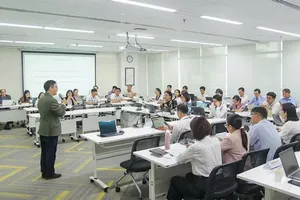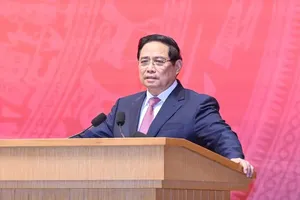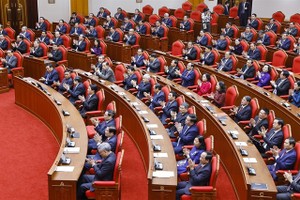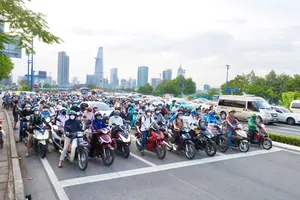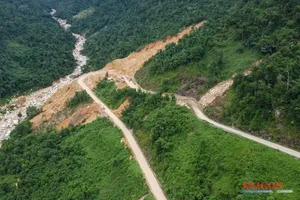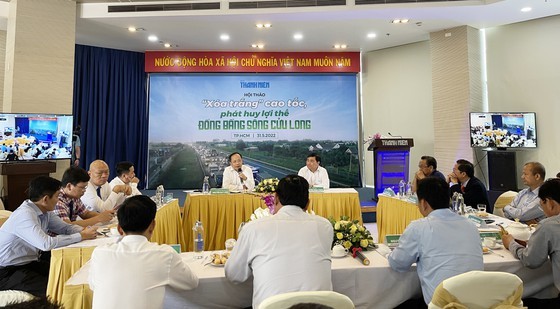 At the seminar
At the seminar
Today, the seminar ‘Clearing highways, promoting advantages of the Mekong Delta’ was organized by Thanh Nien Newspaper with the participation of Deputy Minister of Transport Nguyen Duy Lam, leaders of some Mekong Delta provinces, economists, experts and many large enterprises in the field of transport infrastructure construction across the country.
According to journalist Nguyen Ngoc Toan, Editor-in-Chief of Thanh Nien Newspaper, the Mekong Delta is the largest producer and exporter of food, food, seafood and fruit in the country, contributing about 50 percent of rice production, 95 percent of rice for export, nearly 65 percent of aquaculture production, 60 percent of bred fish for export and nearly 70 percent of fruits of the country. At the same time, this area has an interlaced system of rivers and canals.
However, the Mekong Delta has not been able to promote its full potential and advantages due to limited road, waterway and sea transportation. Meanwhile, many provinces and cities have started building and inaugurated many highways. But for the Mekong Delta, only the Trung Luong - My Thuan highway project with the length of 91 kilometers has been completed and put into use.
At the workshop, Deputy Minister of Transport Nguyen Duy Lam shared that the road system is being invested with a length of about 2,688km, an increase of 52 percent compared to 2002. In which, many large bridge projects have been built contributing to the part connecting the two banks of Tien and Hau rivers smoothly, such as the My Thuan bridge, the Vam Cong bridge, the Cao Lanh bridge, the Can Tho bridge, and the Rach Mieu bridge.
Most of communes have car roads to province’s center. In particular, the program to remove cau khi (monkey bridges) in Vietnam, handmade bamboo or wooden bridges across a stream or gully, has been implemented during the past time with many different capital sources.
When it comes to inland waterways, the upgrade of six main waterway transport routes connecting Ho Chi Minh City and the Southeast with the Mekong Delta region and the upgrade of the first phase of Cho Gao canal have been completed. Twelve seaports, 40 wharves, and 7.6 kilometers of wharves with a total designed capacity of about 31 million tons a year have been built.
Regarding aviation, the region has completed the upgrade of four airports including Can Tho, Phu Quoc, Ca Mau and Rach Gia with a total capacity of 7.45 million passengers a year and 12,000 tons of cargo annually.
According to Mr. Nguyen Duy Lam, linking the Mekong Delta with the Southeast region and Ho Chi Minh City is still limited due to the fragmented topography, weak geological background, seriously affected by climate change, sea level rise, so the construction investment rate is 1.3 - 1.5 times higher than that of other area. In particular, the planning of expressway set by 2050, the Mekong Delta region has about 1,180 kilometers over 9,014 kilometers of the country; furthermore, there will be about 760km by 2030 and after 2030, about 420 kilometers more will be built.
As per the plan from 2021 to 2025, the My Thuan - Can Tho expressway project and My Thuan 2 bridge project will be finished. The Can Tho - Ca Mau route with a length of 109 kilometers will be basically completed. The Government is also submitting to the 15th National Assembly an investment policy on the Chau Doc - Can Tho - Soc Trang route with a length of 188 kilometers.
The Ministry of Transport is setting up an investment project on the My An - Cao Lanh route with a length of 26 kilometers which is expected to start in 2023. The construction of the Cao Lanh - An Huu route with 27 kilometers will also be done. The government will spend money on several items for the exploitation of the Cao Lanh - Lo Te - Rach Soi section according to highway standards.
In the period 2026 - 2030, the Ministry planned to fulfill the Can Tho 2 bridge project and the road leading to the two bridge ends with a length of 15 kilometers, the section 21-kilometer long Chon Thanh - Duc Hoa, the 74-kilometer long section Duc Hoa - My An, the 212-kilometer long section Ha Tien - Rach Gia - Bac Lieu, the 90-kilometer long An Huu - Tra Vinh section, the 68- kilometer long Tra Vinh - Hong Ngu section and the 150-kilometer long highway from Ho Chi Minh City to Soc Trang.
According to the Deputy Minister of Transport’s suggestion, in addition to the central budget, local administrations should take heed of mobilization of social contributions in localities where the highways pass through. Additionally, local governments should manage the allocation of local budgets for highway projects.
Many large projects will be deployed at the same time, leading to a huge demand for construction materials; therefore, local administrations should create favorable conditions for material sources, especially soil and sand to fill the roadbed. In addition, the site clearance is extremely difficult and complicated, which is also decisive to the progress of the project implementation, so it is necessary to have the participation of both the political system and the support and consensus of local inhabitants.



